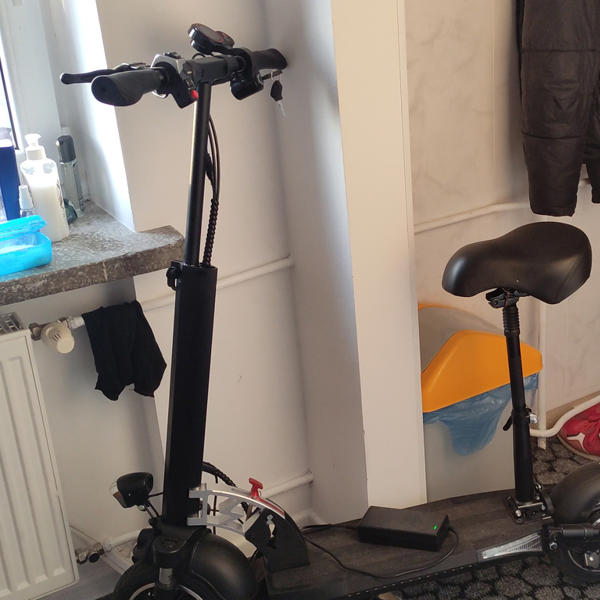With e-bikes and e-scooters becoming ever more popular, it has also become an ever-increasing fire safety concern in both communal areas and individual homes.
Batteries can fail, leak or explode, causing fires that can develop quickly along with creating significant quantities of smoke. This also includes other battery-powered vehicles or toys such as automated cars and hoverboards.
Whilst the benefits of these devices is recognised, aiding to help people get more active, travel more easily it’s important to be aware of the fire safety advice particularly when charging your battery.
The following advice is aimed at assisting you in being able to use these safely, keeping yourself and your family safe along with all other persons in the property whether you live in a flat sharing common areas or within an individual home such as a house or bungalow.

Help keep everyone safe
Please do not store or charge e-bikes and e-scooters on balconies or in communal areas such as hallways, escape routes and lobbies. Due to the recent increase in battery-related fires and for the safety of you and your neighbours, we ask that these devices are charged away from the building, where you have permission to do this.
If you’re unable to charge your e-bike or e-scooter elsewhere, please note the below guidance.
Please take the time to read the key information about risks:
Charging
- Follow the manufacturer’s instructions when charging and always unplug your charger when it’s finished charging.
- Ensure you have working smoke / heat fire alarms in your home and charge the device in an area that is directly covered by these.
- Charge batteries whilst you are awake and alert, so if a fire should occur you can respond quickly. Don’t leave batteries to charge while you are asleep or away from the home.
- Don’t charge e-bikes and e-scooters in bedrooms or where escape routes can be blocked – for example, your hallway obstructing your means of escape.
- If you spot any signs of wear and tear or damage, buy an official replacement charger for your product from a reputable seller.
- Do not cover chargers or battery packs when charging as this could lead to overheating or a fire.
- Do not charge batteries or store your e-bike or e-scooter near combustible or flammable materials.
- Do not overcharge your battery – check the manufacturer’s instructions for charge times.
- Do not overload socket outlets or use inappropriate extension leads (use un-coiled extensions and ensure the lead is suitably rated for what you are plugging in to it).
- In the event of an e-bike, e-scooter or lithium battery fire – do not attempt to extinguish the fire. Get out, stay out, call 999.
Storage
- Store e-bikes and e-scooters and their batteries in a cool place. Avoid storing them in excessively hot or cold areas, or in direct sunlight internally or externally.
- Do not keep any electronic devices in close proximity to the building externally such as on balconies.
- Follow manufacturer’s instructions for the storage and maintenance of lithium batteries if they are not going to be used for extended periods of time.
Maintaining your e-bike or e-scooter
- Always follow the manufacturer’s instructions for charging and using your product.
- Always use the manufacturer-approved battery and charger.
- If you need a replacement battery or charger for your e-bike or e-scooter go directly back to the manufacturer or retailer you bought it from to ensure it’s safe.
- Regularly inspect your product and check for damage or warning signs that your battery might be failing and becoming a fire risk.
- Don’t attempt to modify or tamper with your battery.
Damage and disposal
- Batteries can be damaged by dropping them or crashing e-bikes or e-scooters. Where the battery is damaged, it can overheat and catch fire without warning. Check your battery regularly for any signs of damage and, if you suspect it is damaged, it should be replaced and should not be used or charged.
- If you need to dispose of a damaged or end-of-life battery, don’t dispose of it in your household waste or normal recycling. These batteries, when punctured or crushed can cause fires in bin stores/lorries, recycling and waste centres. Your e-bike or e-scooter manufacturer may offer a recycling service. Alternatively check with your local authority for suitable battery recycling arrangements in your area.
You must stop using or charging your battery immediately if you notice any of the following:
- Overheating: If your device’s battery feels extremely hot to the touch
- Deformation: If your battery looks swollen. Similar signs include any type of lump or leaking from the device.
- Noise: If your battery is making hissing or cracking sounds.
- Smell: If you notice a strong or unusual smell coming from the battery.
- Performance: If your battery does not fully charge or is taking longer to charge than normal.
- Smoke: If your battery or device is smoking, this may commence with a white vapour emitting form the charger/battery.
What to do if your lithium-ion battery is a fire risk
- If the device starts smoking or catches fire, raise the alarm, get out, stay out and call 999 immediately.
- If your battery shows any signs of failure, turn off the device and unplug it from the power source immediately.
Please get in touch
We hope the above information is of use to you and will help in keeping you and your neighbours safe in your homes. If you’d like to discuss any of these issues, please contact your neighbourhood coordinator, in the first instance or the building safety team directly

Safety in your home
It's important you feel safe at home, and it's our job to make sure you are.
Whether it's gas safety, electrical inspections, or fire prevention, we're here to carry out important inspections to help keep you safe. There are also lots of things you can do to protect yourself and your loved ones too.
You can find out more about how to stay safe in your home across our website:
Find out more




